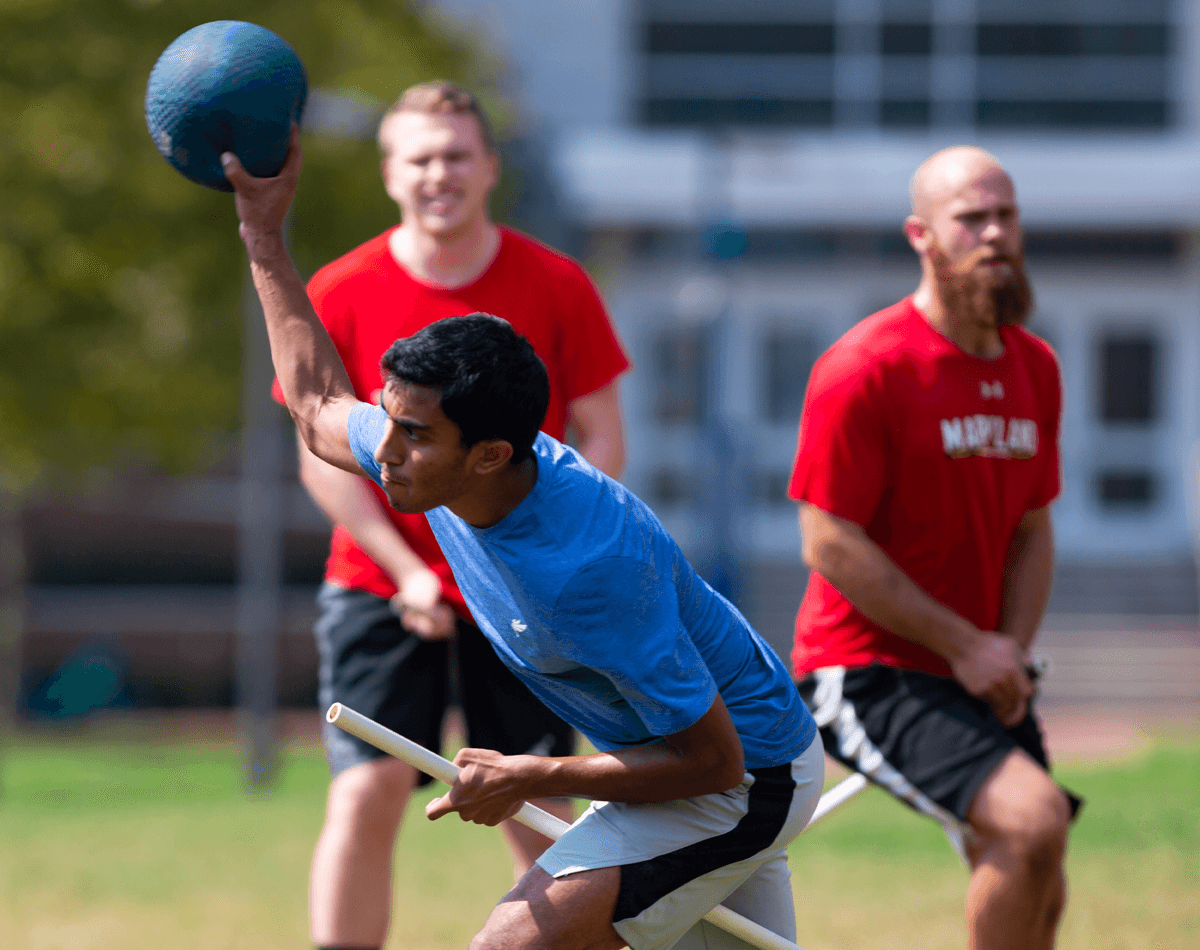- January 10, 2020
- By Annie Krakower
On a field where the bludgers are flying and the snitch is nowhere in sight, a trio of teammates makes a break for the three rings perched at the opposite end. Weaving around other players, they toss the quaffle back and forth before one of them spikes it past the keeper and through a hoop, scoring 10 points for his squad.
Fans of J.K. Rowling’s Harry Potter series can easily identify such a scene as Quidditch, the fictional sport played by broomstick-riding witches and wizards. But the bludgers are really dodgeballs, the quaffle is a volleyball, the flying brooms are PVC pipes and for these players, Gryffindor’s famous seeker is but a footnote in a game that’s no fantasy.
Maryland Quidditch, now in its 11th season, is one of more than 150 teams across the U.S. that play the game inspired by Rowling’s books. As it’s played at UMD, however, it’s a gritty, physical sport rather than a magical fan club.
“Really good teams usually aren’t the Harry Potter-focused ones,” said Vanessa Barker ’20, president of Maryland Quidditch. “We are very sports-focused. When I was a freshman, we were going down to nationals outside Orlando, Fla., and that’s a really long drive, so what we ended up doing is watching all the Harry Potter movies. Half the team hadn’t seen them before.”
Founded in 2005 at Middlebury College, the non-wizarding form of Quidditch—sort of a mixture of basketball, rugby and handball—is now played in more than 40 countries. Co-ed teams of seven take the field straddling 40-inch PVC pipes. (During aggressive play, wooden brooms were causing too many injuries and breaking too often.) Players called chasers try to get the volleyball/quaffle through the goal hoops while beaters hurl dodgeballs/bludgers at them.
After 18 minutes, the snitch is released—not the tiny flying golden ball in the books and movies, but a neutral player wearing yellow with a Velcro tail attached to their shorts. Seekers try to nab the tail to score 30 points and end the game.
With the club sport mentality, Maryland Quidditch practices three times a week. Players ranging from tall and lanky to buff and bearded warm up, execute drills and scrimmage. Despite the occasional passerby stopping to gawk or even take a quick video, players don’t hold back as they push, shove, take opponents out by the legs or slam them to the ground.
“People don’t understand the sport when they’re like, ‘Oh, yeah, it’s from Harry Potter,’” Barker said. “But I’m playing a full-contact sport. It’s super intense.”
Maryland’s hard work has been paying off. It’s notched six mid-Atlantic regional championships and back-to-back Elite Eight appearances in the U.S. Quidditch Cup. One player, chaser and captain John Sheridan ’20 (who, by the way, hasn’t even cracked open “The Sorcerer’s Stone”), was selected to the U.S. national team’s inaugural Developmental Academy last summer and hopes to play in the 2020 Quidditch World Cup.
For Maryland’s team, the ultimate goal is always the national title, but members realize this is a rebuilding year after a few key players graduated. They recruited at events like last fall’s First Look Fair.
“I was yelling out, ‘Full-contact, co-ed sport!’” Sheridan said of the annual showcase for student clubs and organizations. “Saying that it was Quidditch is not a good recruitment strategy.”
UMD, which lost to New York University in the Elite Eight last year, will head to Charleston, W. Va., in April for the 13th U.S. Quidditch Cup.
“It’s fun to watch—it’s kind of crazy. It looks like there’s just balls flying,” Barker said. “This really is just about the sport and the team and the camaraderie.”
A Quick Guide to Quidditch
Can’t keep up with the action? Or haven’t read the Harry Potter series? Here’s a brief, magical list of the major terms:
QUAFFLE: A volleyball that chasers throw through one of three hoops to score 10-point goals. Keepers guard the hoops.
BLUDGERS: Two dodgeballs that beaters chuck at opposing players. If hit, players must go back to their side of the field before returning to the game.
SNITCH: A neutral yellow-clad player with a Velcro tail attached to their shorts. Seekers try to grab the tail after 18 minutes to score 30 points and end the game.
BROOMS: Rigid plastic poles between 39 and 41 inches long, with no splinters or sharp points, that players hold between their legs. PVC pipes are common. Flying powers are not.

